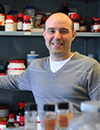07:00 | Morning Coffee, Breakfast Pastries, and Networking in the Exhibit Hall |
07:30 |  Technology Spotlight: Technology Spotlight:
Breakfast Briefing: Novel Microfluidic Normally Closed Valve, Normally Open Valve, Pumps and Reservoirs Using New Over molded Elastomers
Dylann Ceriani, Principal Product Development Engineer, Symbient Product Development Inc
Over molding of plastics with elastomers is common, but due to limitations of TPE materials, their use in microfluidic applications have been limited. Recent developments in TPE materials have given certain TPE materials properties similar to silicone. Silicone has attractive properties for microfluidic applications, but as an over molding material, its drawbacks have limited its use. Design solutions for over molded valves, pumps and reservoirs using TPE materials that solve problems associated with elastomeric valves and pumps made with other methods and elastomeric materials are described. Solutions are presented to issues including leaking, sealing and assembly. A basic design for a normally closed valve and expandable reservoir that is made possible by overmolding with the new elastomers and would not be possible to manufacture with any other method is illustrated in detail. Previously, normally closed valves have been difficult to develop and/or costly to implement, but by using this over molded design they add only nominal, if any, cost to the part. Exchanging fluids between fixed volume reservoirs without creating a void or adding pressure and /or bubbles to the system has always been a problem. Expandable reservoirs eliminate these challenges because they do not add any dead air in the system, reducing the risk of bubbles, additionally they can be used to dissipate, equalize and capture pressure generated by a user or a pump.
|
|
Session Title: Emerging Theme in the Microfluidics/LOAC Field -- Organs-on-Chips |
| |
08:00 |  | Keynote Presentation Human Microphysiological Systems: Organs-on-Chips for In Vitro Efficacy, Safety, and Toxicity Testing
Danilo Tagle, Director, Office of Special Initiatives, National Center for Advancing Translational Sciences at the NIH (NCATS), United States of America
Advances in basic and preclinical science continue to fuel the drug discovery pipeline, however only a small fraction of compounds meet criteria for approval by the US FDA. More than 30% of promising medications have failed in human clinical trials because they are determined to be toxic despite promising pre-clinical studies in animal models, and another 60% fail due to lack of efficacy. The challenge of accurately predicting drug toxicities and efficacies is in part due to inherent species differences in drug metabolizing enzyme activities and cell-type specific sensitivities to toxicants. To address this challenge in drug development and regulatory science, the US NIH has invested 75 million dollars over a 5-year period to launch in 2012 the Microphysiological Systems (MPS) or Organs-on-Chips Program to develop alternative approaches that would enable early indications and potentially more reliable readouts of toxicity or efficacy. |
|
08:30 | Microfluidic Microphysiological Microenvironments
Abraham Lee, Chancellor’s Professor, Biomedical Engineering & Director, Center for Advanced Design & Manufacturing of Integrated Microfluidics, University of California-Irvine, United States of America
This presentation would introduce our lab’s effort in developing microfluidic lab-on-a-chip devices to establish and control microenvironments conducive to microphysiological 3D tissues for biomedical applications including drug screening and developing therapeutics. |
09:00 | Artery-on-a-Chip Analysis of Cardiovascular Disease
Scott Simon, Professor of Biomedical Engineering, University of California-Davis, United States of America
Monocyte activation and adhesion to inflamed endothelium is an obligate step in the initiation of atherosclerosis. Despite the accepted paradigm of atherosclerosis as an inflammatory disease, population-wide studies that correlate established biomarkers in blood (e.g., chemokines, myeloperoxidase, c-reactive protein) with the progression of coronary artery disease are lacking. In particular, there are no personalized quantitative measures of activation at the level of the participating immune and vascular cells that provide predictive power for the occurrence of acute myocardial infarction. We will introduce an artery-on-a-chip device that provides a measure of monocyte and endothelial inflammatory activation. These cell based parameters correlate better than established biomarkers with the risk of cardiovascular events in patients. |
09:30 |  | Keynote Presentation Multi-organ Chips for Drug Development
Michael Shuler, Samuel B. Eckert Professor of Engineering, Cornell University, President Hesperos, Inc., United States of America
Effective human surrogates, created from combining human tissue engineered constructs with micro-fabricated systems, could have a major impact on drug development, particularly in making better decisions on which drugs to take into human clinical trials. Our designs are guided by physiologically based pharmacokinetic models. We will describe approaches to use “pumpless”, low cost platforms to build such human surrogates for evaluation to toxicity and efficacy of drug candidates. |
|
10:00 | Coffee Break, Networking, Visit the Exhibitors and Poster Viewing |
10:30 | Nanoliter-Scale Protein Quantification in Biological Matrices using DNA Annealing and Melting
Christopher Easley, C. Harry Knowles Professor, Auburn University, United States of America
Recent breakthroughs in cellular co-culture and organ-on-a-chip platforms have revealed that the scale and operation in microfluidic systems is well-matched with that of organized biological tissues. As shown by our group and others, microfluidic devices permit unique and valuable approaches for hormone secretion sampling, particularly from small amounts of endocrine tissue. These microanalytical systems possess great value in improving our understanding of biology. Unfortunately, the development of compatible, simple-readout protein assays has lagged behind these fluidic advancements. To address this need, we have developed several versions of DNA-driven proximity immunoassays that are well-matched with microfluidic sampling volumes, i.e. the picoliter to nanoliter scale. |
11:00 | Engineering Perfusable Vessel Network in Microfluidic Device for Organ-on-a-Chip Application
Noo Li Jeon, Professor, Seoul National University, Korea South
This presentation will describe a reproducible, in vitro approach to form perfusable 3D microvascular networks on a microfluidic chip. The vessels can be formed by angiogenesis or vasculogenesis. These engineered blood and lymphatic vessels exhibit morphological and biochemical markers of tight junctions, apical-basal polarity, basement membrane deposition, and up-regulated markers in response to inflammatory cues. A novel microfluidic device was designed and tested for real-time imaging of various steps of cancer metastasis and immune cell transmigration. Perfusable microvascular networks formed within the microfluidic device reproduce the 3D cellular niche, facilitating high-resolution live imaging of cancer cell extravasation and immune cell intra/extravasation. This approach provides a platform for developing physiologically complex but experimentally straightforward human disease models and holds potential for medical and pharmaceutical applications in drug screening and basic cancer biology and immunology. |
11:30 | 3D Printed Lab-on-Chip Device for Biomarker Discovery and Personalized Medicine
Mei He, Assistant Professor, University of Kansas and Chief Science Officer, Clara Biotech, United States of America
Developing low-cost biomedical devices for biomarker discovery and personalized medicine is growing incredibly in recent years. The classical microfabrication of low-cost Lab-on-Chip biomedical devices usually requires specialized skills or certain laboratory infrastructure. In contrast, 3D printing technology will be introduced in this presentation for direct concept-to-chip fabrication of LOC devices without the need of laboratory setting. The applications to biomarker discovery and personalized medicine will be discussed. The centralized one-touch fabrication process and monolithic stand-alone LOC device will yield a key transformative technology for disease diagnosis and management in resource-limited area.
|
12:00 |  Technology Spotlight: Technology Spotlight:
Emulating Pipettes: Using Novel Blister Concepts for Fluid-on-Board Devices
David Wright, CEO, Wi, Inc.
Diagnostic technology often relies on time intensive laboratory techniques such as pipetting. In an attempt to bring bench top assays to diagnostic cards, blisters with frangible seals have been used but have yielded questionable results. New developments in blister technology make it possible to more closely imitate the pipetting process and as a result conduct successful rapid diagnostic testing. In this lecture we will discuss the crucial factors for creating successful fluid on board devices using novel concepts in blister technology: determining placement of the blister, the introduction of air, and volume control. We will also discuss the importance of creating effective packaging that protects blisters.
|
12:30 | Networking Lunch, Visit the Exhibitors, and Poster Viewing |
13:30 |  Technology Spotlight: Technology Spotlight:
Universal Microfluidic-Enabled POC platform – Technical Solutions for Complex Integrated Cartridges
Holger Becker, Chief Scientific Officer, Microfluidic ChipShop GmbH
An attractive approach for cartridge-based solutions for point-of-care diagnostics is a system which is capable of performing a broad range of diagnostic assays such as molecular diagnostic, immunodiagnostic and clinical assays with a single system, comprising one instrument and a family of microfluidics-enabled cartridges for the different disease cases. In this paper, we will present such a system and introduce the principles of the microfluidic cartridge architecture as well as different technical solutions ranging from sample prep of complex samples like sputum, nucleic acid extraction to cartridge-based amplification methods and technologies for on-cartridge valveing and reagent storage. Examples for different types of assays will be given.
|
|
Session Title: Emerging Themes and Applications using Microfluidics/LOAC |
| |
14:00 |  | Keynote Presentation Next Generation Real-Time Clinical Monitoring Using Microfluidic Devices
Martyn Boutelle, Professor of Biomedical Sensors Engineering, Imperial College London, United Kingdom
Modern intensive care medicine seeks to protect vunerable tissue from damage by monitoring the pattern of changing physical, electrical and chemical changes taking place in tissue – multimodal monitoring. Microfluidic lab-on-chip devices coupled to microdialysis sampling probes provides a new way for measuring real-time chemical changes. The low volume flow rates (0.2 – 2 µL / min) of microdialysis probes are ideal for linking to microfluidic lab-on-chip analysis devices. Concentrations of key biomarker molecules can then be determined continuously using either electrochemically (using amperometric, and potentiometic sensors) or optically. Droplet-based microfluidics, by digitizing the dialysis stream into discrete low volume samples, (a) allows rapid concentration change to be detected without the effects of the temporal smearing caused by dispersion, and (b) allows dialysate droplets to be quickly transported from the patient or surgical field to the analysis chip. This talk will overview successful design, optimization, automatic-calibration and use of both droplet-based and continuous flow microfluidic analysis systems for real-time clinical monitoring. Examples will be taken from our recent work during reconstructive surgery and, extended monitoring of the traumatically injured brain in the intensive care unit. |
|
14:30 | Modeling and Simulation of Microfluidic Devices
Matthew Hancock, Managing Engineer, Veryst Engineering, LLC, United States of America
Modeling and simulation are key components of the engineering development process, providing a rational, systematic method to engineer and optimize products and dramatically accelerate the development cycle over a pure intuition-driven, empirical testing approach. Modeling and simulation help to identify key parameters related to product performance (“what to try”) as well as insignificant parameters or conditions related to poor outcomes (“what not to try”). For microfluidic devices, modeling and simulation can inform the design and integration of common components such as micropumps, manifolds, and channel networks. Modeling and simulation may also be used to understand and optimize on-chip processes such as mixing, dispensing, heat transfer, species transport and diffusion, reactions, surface tension & wetting, and flow interaction with biological material. I will discuss how an array of modeling tools such as scaling arguments, analytical formulas, and finite element simulations may be leveraged to address these microfluidic device development issues. I will also work through a few examples in detail. |
15:00 | Coffee Break, Networking, Visit the Exhibitors and Poster Viewing |
15:30 | Characterization of a Two-Tissue Microfluidic Platform for Modeling Cytotoxic Effects of Reactive Metabolites
Leslie Benet, Professor, Bioengineering & Therapeutic Sciences, University of California-San Francisco, United States of America
The limited ability of in vitro human liver systems to model the cytotoxic effects of reactive metabolites is currently an impediment to improving the preclinical prediction of drug safety. Hepatic cell-based models in use today generally lack the stably long-enduring enzymatic and transporter competency, as well as the fluidic connectivity to cell-based models of other organs, sufficient to register hepatotoxicity when reactive metabolites are involved in the mechanism of action, or when a liver-initiated toxicity is manifested in another organ. This talk will review experimental results generated on Hurel Corporation’s HµRELflow™two-tissue, microfluidic, hepatic cell-based assay platform, utilized with reference cytotoxicants known to involve metabolism in their cytotoxic pathways. |
16:00 | Nanofluidic Logic Circuit Elements For Ionic Flow Control
Shaurya Prakash, Associate Professor, Department of Mechanical and Aerospace Engineering, The Ohio State University, United States of America
A nanofluidic device with an embedded and fluidically isolated gate electrode, analogous to solid state semiconductor field effect devices were developed for exquisite ionic flow control. Specifically, the gated electric field allows for tunable control of both the magnitude and direction of the net ionic current through the nanochannels as a function of electrolyte concentration and gate electrode location permitting device operation as a multi-state switch and selective ion transport as a key advance towards artificial ion pumps and ion channels. |
16:30 | Microfluidic Systems for Measuring Dynamics of Hormone Secretion
Michael Roper, Associate Professor, Florida State University, United States of America
We have developed several analytical systems that are being used to measure and understand various aspects of the secretion dynamics of islets of Langerhans. In this talk, a microfluidic system will be discussed that can simultaneously measure multiple peptides secreted from islets of Langerhans with high temporal resolution. This system allows us to examine hormone secretion profiles from single or groups of islets after a challenge with a stimulant. A microfluidic system will also be described that is being used to mimic an in vivo feedback loop between the pancreas and peripheral tissues. Use of the appropriate conditions synchronizes individual islets producing population oscillations of intracellular [Ca2+] and insulin release with similar time periods as those observed in vivo. |
17:00 | Micro Swimmer Navigating in Microfluidic Environments
Sung Kwon Cho, Associate Professor, University Of Pittsburgh, United States of America
There have been a large number of research attempts to develop mircoswimmers to navigate passages in microfluidic devices and even narrow spaces inside human bodies to perform drug delivery, micro surgery, bio sensing, imaging, etc. This talk presents an underwater micro propulsion swimmer where a gaseous bubble trapped in a microchannel and oscillated by an external acoustic excitation generates a propelling force. The propelling swimmer is designed and microfabricated out of parylene in micro scale (equivalent diameter of the cylindrical bubble is around 60 µm) using microphotolithography. The propelling mechanism is studied and verified by computational fluid dynamics (CFD) simulations as well as experiments. The acoustically excited and thus periodically oscillating bubble generates alternating flows of intake and discharge through an opening of the microchannel. Propelling motions by a single bubble as well as an array of bubbles are achieved in microscale. In addition, the micro swimmer demonstrates payload carrying. Moreover, using multiple bubbles with frequency matching method, Steering capability is achieved. 2-D steered propelling is demonstrated in a T-junction channel. |
17:30 | The Biomolecular Prototyping Unit (BPU) – Application to Enzyme Design, Personalized Medicine, and Genome Engineering
Peter Carr, Senior Staff, Massachusetts Institute of Technology (MIT), United States of America
We are engineering a microfluidic pipeline, the Biomolecular Prototyping Unit (BPU) to rapidly produce and test functions that can be programmed using DNA. Our ultimate goal is to integrate short DNA (oligonucleotide) synthesis, larger scale DNA assembly (to multiple kilobase pairs), on-chip expression (cellular and cell-free options), and diverse assays to quantify the encoded functions. I will present our current progress developing and integrating microfluidic modules for the BPU. Current application areas include [1]. constructing and testing many variants of engineered enzymes; [2]. assessing drug efficacy against a range of potentially resistant viral proteins; and [3]. evaluating designs for extreme genetic codes to be implemented genome-wide in bacteria. |
18:00 | Close of Day 3 of the Conference |












